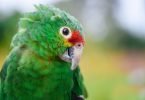Parrots are one of the most interesting and amusing bird species. This is why most pet owners end up bringing home parrots to their own homes. They are a unique group of animals, and there is no denying that parrots are special and one-of-a-kind. It’s not surprising to find out that they have a disease named after them called Parrot Fever. Don’t be tricked though; Parrot Fever may infect a variety of species of birds. Hence, it’s important to find out more about this disease if you own any breed of bird.
To know more about common health problems in birds, click this article Bird Health Problems – What You Need to Know About the Types, Treatments, Symptoms, and Prevention.
What is Parrot Fever?
Parrot Fever or Psittacosis is an infectious disease. It is named after the Greek word psittako, which translates to parrot. It is responsible for flu-like illnesses in different species of birds and other animals. Although the disease is named after a parrot, it can also infect other types of birds. Moreover, it also infects other mammals and even humans.
What causes Parrot Fever?
Parrot Fever or Psittacosis is caused by the bacterium Chlamydia psittaci or C. psittaci. Other species of Chlamydia also cause Parrot Fever, but C. psittaci is the most common and most widely studied.
Avian Chlamydiosis is also another term used because of the etiologic agent. It might be caused by a bacterium called Chlamydia. Still, it‘s essential to know that the bacterium is different from the one causing the sexually transmitted disease in humans. It is Chlamydia trachomatis that causes the STD and only infects humans. Meanwhile, C. psittaci can infect both birds and humans.
Is Parrot Fever contagious?
This disease is considered as an infectious disease. Therefore, this disease is contagious. It can be transmitted through various modes. Thus, it’s important to take precautions because the disease is highly transmissible.
Some birds also serve as carriers. This means that they have the bacteria in their system but are not showing any signs and symptoms. However, these birds are capable of spreading the bacteria to other birds as they go.
How do birds get Parrot Fever?
Birds get Parrot Fever in various ways. Inhalation or via the respiratory tract is the most common mode of transmission. Dust from feathers, fecal material particles and secretions can all be inhaled by birds. These things are all sources of P. psittaci.
In some cases, the ingestion of fecal materials and other food contaminated by the bacteria may transmit the infection. Thus, it is important to observe proper hygiene when handling any waste or food of birds.
What are the signs and symptoms of Parrot Fever?
Initially, Parrot Fever appears to be asymptomatic. In fact, some birds don’t even manifest any symptoms throughout the disease duration. Within several days after contracting the disease, infected birds would experience high fevers. Moreover, birds would manifest with cachexia or wasting due to weight loss.
One of the most telling signs for Parrot Fever is conjunctivitis. Birds would manifest with red, swollen, itchy eyes. They would also experience some form of diarrhea during illness. Furthermore, you might also notice some loss of appetite in your bird. Along with this, weight loss is also evident.
Take note that the presence of signs and symptoms vary depending on the bird’s species and immune system. The signs and symptoms are also not specific. Thus, although your bird might show the symptoms, it doesn’t mean that they are inflicted with Parrot Fever.

How do I check my bird for Parrot Fever?
There is no definite test bird owners can use at home to confirm the presence of Parrot Fever in their pet birds. This is because the signs and symptoms of this disease are not very specific. If you feel like your bird is experiencing some Parrot Fever symptoms, don’t hesitate to bring them to the vet.
Moreover, don’t forget to quarantine suspected birds, especially if you have other pets as well. Keep yourself protected, too. Wear gloves while handling fecal material and food. Feces, respiratory secretions, as well as mere feather dust or sheddings all, carry the bacteria. Don’t forget to observe proper handwashing before and after handling pets.
How do you diagnose Parrot Fever in birds?
Laboratory tests like Complete Blood Count, antigen, and antibody testing, as well as bacterial cultures, are all part of complete diagnosis. These will all confirm the presence of C. psittaci in the bird’s body. Tissue sampling and biopsy are also mainstays in the diagnosis. In this method, the vet will extract some tissue from the bird. Doctors can then visualize the bacteria under a microscope. The presence of the bacterium in the tissues sampled will confirm the diagnosis of Parrot Fever.
Note that the presence of the bacteria in the stool will not mean that the bird has the disease. It may only be indicative that the bird has an infection. Moreover, stool cultures can also be positive in carrier states.
Is Parrot Fever treatable?
Parrot Fever, if untreated, can be deadly to the infected bird. The good news is that Parrot Fever is treatable. C. psittaci, a bacterium, causes Parrot Fever. Antibiotics are the treatment of choice for most bacterial infections.
Reports say that half of the infected birds die from Parrot Fever if the proper treatment and management is not given as soon as possible. Thus, if you spot your bird showing some signs and symptoms, you should act immediately. Bring your pet bird to the nearest veterinarian for a complete check-up and work-up.
The disease may be alarming and fatal. However, with the right treatment, birds have a very high chance of recovery. Keep in mind to administer the drugs at the right time always. You want to prevent the development of resistance to Doxycycline. Moreover, antibiotics are also time-sensitive. Thus, it’s essential to deliver the antibiotics without fail consistently.
How do you treat Parrot Fever?
Your bird’s veterinarian would typically prescribe antibiotics like Doxycycline to treat Parrot Fever. This particular antibiotic belongs to the Tetracycline class of antibiotics. They work by targeting the enzyme responsible for the bacteria’s protein synthesis. Targeting them prevents the bacteria from further replicating, thus killing them.
Doctors usually prescribe Doxycycline for different types of infections. This includes zoonotic diseases like Leptospirosis, among many others. Moreover, this is also prescribed to treat diseases like pneumonia, skin diseases, etc. It’s considered to be a powerful antibiotic.
For Parrot Fever, your bird’s vet will prescribe Doxycycline for over 45 days. The duration of treatment is longer than usual. This is because of the unique characteristic of Chlamydia psittaci. These bacteria hide in white blood cells of the bird. These specific cells are called macrophages. The antibiotic would have to wait for days until the bacteria are released from the macrophages. Only then can Doxycycline act on the bacteria.
The good thing about Parrot Fever is it is highly curable. If you administer the drug at the right time and dosage, and you remain consistent, your bird can recover quickly.
How do you prevent Parrot Fever?
Parrot Fever is an infectious disease. Proper hygiene is one of the most effective ways you can do to prevent it from reaching your bird.
Regular cleaning of bird cages is a must. This is most true if your bird is showing signs of any disease. Doing so will also be beneficial to you as a bird owner. Remember that Parrot Fever also affects humans. Thoroughly clean the birdcage with a high-quality bird cage cleaner. Choose one that is effective but safe and gentle. You don’t want to use a cleaner that could be toxic to your pet.
For more effective cleaning, you may add a brush cleaner to your routine. This will make sure you can scrub down even the smallest particles of dirt on the cage. If you have problems with stains on bird cages, use a heavy-duty stain remover. This one can erase stains from different types of materials like leather, fabric, cotton, wood, and many others.
For added convenience, use birdcage liners. These liners are convenient if you can’t find time to clean and scrub down the cage regularly.
Strengthening and boosting your bird’s immune system can be beneficial in preventing the development of the disease. As with any type of infectious disease, a well-functioning immune system is key. Regularly feed and nourish your birds with nutritious bird feeds. If possible, you can also incorporate some probiotics in the diet as well.
Adding vitamins and minerals to the diet can also help your bird’s immune system. Simply mix them with bird food or water to make sure they’re being taken regularly.
Parrot Fever can be a dangerous disease for most pet owners. It is important to remember to act quickly when your bird falls ill. Educating yourself about the disease is one of the best things you can do as a pet owner. For further questions and clarifications, you may always coordinate with your veterinarian.
To know more about common health problems in birds, click this article Bird Health Problems – What You Need to Know About the Types, Treatments, Symptoms, and Prevention.






